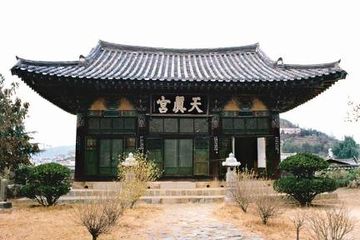밀양 천진궁
| 천진궁 Cheonjingung Shrine |
|
 천진궁, 국가문화유산포털, 문화재청. |
|
| 대표명칭 | 천진궁 |
|---|---|
| 영문명칭 | Cheonjingung Shrine |
| 한자 | 天眞宮 |
| 주소 | 경상남도 밀양시 중앙로 324 (내일동, 영남루) |
| 지정(등록) 종목 | 경상남도 유형문화재 제117호 |
| 지정(등록)일 | 1974년 12월 28일 |
| 분류 | 유적건조물/인물사건/인물기념/사우 |
| 수량/면적 | 2동 |
| 웹사이트 | 천진궁, 국가문화유산포털, 문화재청. |
|
|
|
해설문
국문
단군과 역대 왕조를 세운 시조의 위패를 봉안한 사당이다. 중앙 맨 윗자리에는 단군의 영정과 위패를 모셨고 동쪽 벽에는 부여·고구려·가야·고려의 시조, 서쪽 벽에는 신라·백제·발해·조선의 시조 위패를 봉안했다.
조선 현종 때인 1665년 객사(客舍)*인 공진관(拱振館)의 부속 건물로 건립되었으나 경종 때부터 공진관을 대신해 전패(殿牌)*를 모시고 객사로 활용됐다. 영조 때 불에 탔으나 다시 지었다. 일제강점기에는 일제가 민족정기를 말살하기 위해 위패를 땅에 묻고 헌병대 감옥으로 사용했다.
1952년 단군봉안회가 생기면서 단군과 삼국의 시조왕, 고려 태조 등의 위패를 모시고 대덕전(大德殿)이라 하였다. 1957년 크게 수리하면서 이름을 천진궁으로 바꾸고 매년 봄·가을 어천대제(御天大祭)와 개천대제(開天大祭)를 봉행하고 있다. 정면 3칸 측면 2칸에 팔작지붕이다. 정문은 만덕문(萬德門)이다.
- 객사: 조선시대에 왕의 위패를 모시고 공식 행사를 하던 건물로 사신이나 다른 곳에서 온 벼슬아치를 대접하고 묵게 하던 숙소.
- 전패: 조선시대 지방 관청 객사에 ‘전(殿)’자를 새겨 봉안하던 목패로 왕을 상징함.
영문
Cheonjingung Shrine
Cheonjingung Shrine is a shrine enshrining the spirit tablets of the founders who built (established?) the nine countries that appear in Korean history. In the center of the shrine's interior are enshrined a portrait and a spirit tablet of Dangun, the founder of the first Korean country, Gojoseon (2333-108 BCE). The spirit tablets of the founders of Buyeo (2nd century BCE-494 CE), Goguryeo (37 BCE–668 CE), Gaya confederacy (42-562), and Goryeo (918-1392) are enshrined on the left side, and the spirit tablets of the founders of Silla (57 BCE-935 CE), Baekje (18 BCE-660 CE), Balhae (698-926), and Joseon (1392-1910) are enshrined on the right side.
Originally, this building was fist built in 1665 as an auxiliary building of a local government office and after this it was used as a guesthouse of the local government office. Guesthouses, called gaeksa in Korean, are buildings that held a wooden tablet of the king and were used as temporary lodging facilities for envoys or officials from other areas. It was destroyed by fire in 1739, rebuilt in 1749, and underwent a major renovation in 1844. During the Japanese colonial period (1910-1945), the Japanese buried the spirit tablets underground as part of a colonial policy to suppress Korean folk traditions, and the building was used as a prison by the military police.
In 1952, after the liberation from Japanese colonial rule, the spirit tablets were re-enshrined in their original places and the building underwent a major renovation in 1957. Ancestral rituals are still performed twice a year, in spring and fall.
영문 해설 내용
천진궁은 한국 역사에 등장하는 9개 국가를 세운 시조들의 위패를 모신 사당이다. 사당 내부 중앙에는 한국 최초의 국가인 고조선의 시조 단군의 영정과 위패가 모셔져 있다. 왼쪽에는 부여, 고구려, 가야, 고려 시조의 위패를, 오른쪽에는 신라, 백제, 발해, 조선 시조의 위패를 모시고 있다.
이 건물은 원래 1665년 관아의 부속 건물로 처음 세워졌으며, 이후에는 관아의 객사로 사용되었다. 객사는 왕의 전패를 모시고, 사신이나 다른 지역에서 온 관리들이 숙소로 사용하던 건물이다. 1739년 화재로 소실된 것을 1749년에 다시 세웠고, 1844년에 크게 수리하였다. 일제강점기에는 일제가 한국의 민족정기를 말살하기 위해 위패를 땅에 묻었고, 건물을 헌병대 감옥으로 사용하기도 하였다.
해방 이후인 1952년 다시 위패들을 원래대로 모셨고, 1957년 건물을 크게 수리하였다. 매년 봄과 가을에 제사를 올리고 있다.
참고자료
- 영남루 천진궁을 아세요?, 국제신문, 2013.9.29 http://www.kookje.co.kr/news2011/asp/newsbody.asp?code=8800&key=20130929.88001093837 -> 세운 시기 관련 부사 이름 확인
- 밀양 천진궁(天眞宮)에서 하늘을 만나다, K스피릿, 2012.4.2. http://www.ikoreanspirit.com/news/articleView.html?idxno=31467 -> 영남루 경내에 있는 건물로 원래 이곳은 요선관이 있던 자리이다. 효종 3년(1652)에 지었으며 공진관이라 부르기도 한다. 영조 15년(1739)에 불탄 것을 영조 25년(1749)에 다시 지었으며, 헌종 10년(1844)에 크게 수리하였다. 1952년 단군봉안회가 생기면서 단군 및 삼국의 시조왕, 고려 태조(재위 918∼943)의 위패를 모시면서 대덕전이라 하였으나 1957년에 천진궁으로 이름을 바꾸었다.